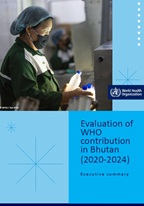
Publications
The Information Management and Dissemination Office of the WHO South-East Asia Region consolidates publishing activities throughout the Region.
The South-East Region Publications Office works in close coordination with WHO Press to form an integral part of the knowledge management and communications culture of the World Health Organization. Closely tied to the work of WHO, each publication articulates part of a global plan, conveying information that can push the world forward through the protection and promotion of health with commitment to quality and dedicated focus on customer service.
Full texts of all South-East Asia Region information products are available and downloadable online from the WHO SEARO IRIS site.
We welcome your comments and suggestions for the improvement of this site at the following address: searolibrary@who.int.
Featured Publications
All →Nurturing hopes: Progress in implementing the Global Initiative for Childhood Cancer in the WHO South-East...
Launched by the WHO in 2018, the Global Initiative for Childhood Cancer (GICC) aims to achieve at least a 60% survival rate for children with cancer globally...

The evaluation was commissioned by WHO to assess its contribution to Bhutan’s health sector during 2020–2024 in line with the WHO Country Cooperation...

WHO contribution in Bhutan (2020-2024): Evaluation report
The evaluation was commissioned by WHO to assess its contribution to Bhutan’s health sector during 2020–2024 in line with the WHO Country Cooperation...
Technology Transfer and Intellectual Property Management for Public Health in the Regional Office for...
The present document is a framework for technology transfer for intellectual property management and access to medical products in the context of Public...

